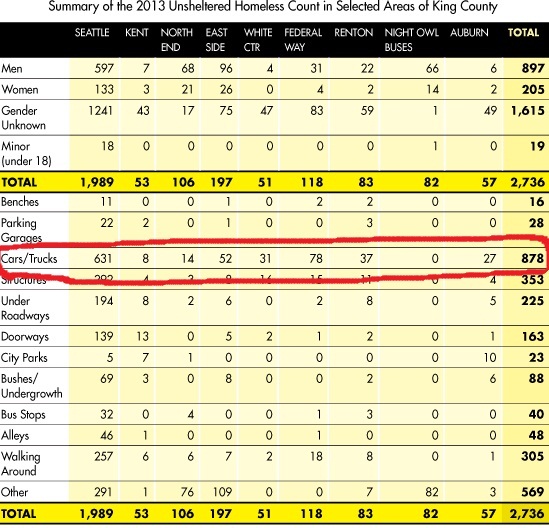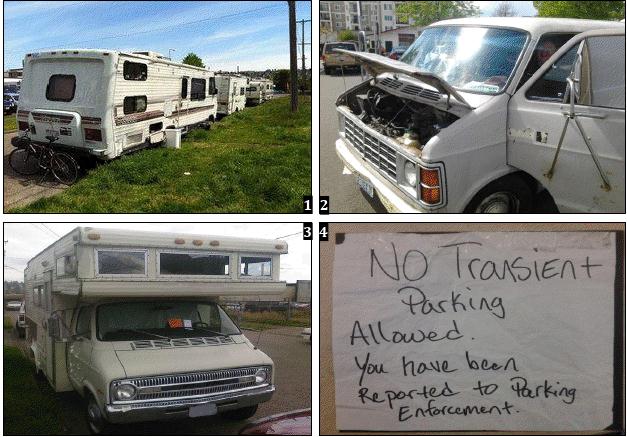We continue our “Everyone Counts” series with insight into the homeless Point in Time counts occurring across the country. In this post, we hear again from Ashwin, a student at Seattle University. He volunteered with a One Night Homeless Count team that explored the Seattle neighborhood of Ballard, where many people live in vehicles. In fact, vehicle residents make up the largest percent of the homeless population on “the streets” in King County. How do we so often miss the presence of this population? Ashwin shares how his eyes were opened.
By Ashwin Warrior, Project Assistant, Seattle University’s Project on Family Homelessness; Senior, Seattle University.
For the past few years I have volunteered with Street Soccer Seattle, an organization located in Seattle’s University District that uses soccer to work with homeless and formerly homeless youth. I imagined that such experiences would prepare me for whatever the One Night Count could throw at me. I was wrong.
It wasn’t the harsh reality of seeing individuals living on the street that affected me; rather it was their conspicuous absence—the absence of anyone at all. Over the course of three hours I did not see a single human being outside of the other volunteers and a parking lot security guard. And while I wish this pointed to a reduction in levels of homelessness, it instead served as a harrowing lesson for my evening: Sometimes, homelessness hides in plain sight.
We were assigned to Ballard, a neighborhood northwest of downtown Seattle.

Our group was tasked with scouring Ballard-area parking lots, looking for signs of people living in cars, or “vehicle residency.” This is by far the largest group of unsheltered people in King County.

We were lucky to have Graham Pruss, chair of the Ballard Community Taskforce on Homelessness and Hunger, serve as our guide for the evening.
Graham completed his honors thesis at UW with an anthropological study on vehicle residency, a project that included him spending time living out of a van to fully understand what it means to live without a stable home. Since then, he has been working with city government and various non-profit agencies to specifically address the issue of vehicle residency, and has conducted a study on the issue as a research fellow at Seattle University.

On the evening of the 2013 One Night Count, Graham opened my eyes to a form of housing instability I had never before encountered. I spent my three hours walking through parking lots, looking for telltale signs of human habitation: a window cracked for ventilation, warm breath condensing on glass, cars packed to the hilt with a family’s entire possessions. Our group acknowledged each heartbreaking sign with a nod, a sigh, and a mark on a clipboard, our silence carrying deep sorrow.
As Graham put it, vehicle residency describes a community of people whose survival strategy is often built on invisibility. Despite their best efforts, however, they have not gone unnoticed. These days it’s harder than ever for those living on the precipice. Individuals living out of their car or RV face a dearth of facilities, and new scofflaw laws that threaten immobilization, or worse—impoundment. Meanwhile, “no overnight parking” signs continue to sprout up all over the city at an alarming rate.
There are reasons for hope, however. Our Redeemer’s Lutheran in Ballard recently received a grant from the city to a pilot a Safe Parking program, which the city hopes will serve as a model for providing refuge for vehicle residents while assisting them with the transition into stable housing.. As of December, only one other church has signed on, and only seven spots are available. Nonetheless, the program appears effective; 18 of the 28 people who have made use of the program, and all of the families with children, have been able to get off the street.
It’s a small step forward, but there remains a long way yet to go. Last year, 791 people were counted as living in a car or truck during the annual count. This year, at least 2,736 men, women and children were counted without shelter. Of those, an estimated 878 people were counted in vehicles, 631 in Seattle alone — by far the largest segment of the count, and an increase of 2 percent over the previous year.
At the end of the count, with the rising sun returning the sky to its natural Seattle gray, I left more grateful than ever for the roof over my head, a little more aware of the cars and trucks lining the streets, and convinced that it will take a concerted community effort to truly end homelessness.